![]()
![]()
![]()
![]()
![]()
![]()
![]()
![]()
The Breeding of Discus
Discus require a higher temperature than most tropical fish, about 28 degrees Celcius. If your pair of Discus raise their own young, great! If they still eat them after several layings, then the following may help you to raise them artificially. (The fry normally graze the slime of the parents for the first few days).
After the eggs have been laid for a few hours, remove them to a tank with the same water and temperature. Place an airstone near them to circulate the water. Add a multicure such as methylene blue. Raise the temperature to 30 degrees Celcius. When the fry are free swimming, the hard part begins. Mix together some powdered egg yolk, gelatine, agar-agar, and Metamucil. Place the fry in a shallow dish, no airstone while feeding, and smear a small amount of the mixture to the side of the container. Feed four times a day. It may be necessary to add an antibiotic (such as 250mg penicillin per 20 litres of water). After 5 or so days, begin feeding brine shrimp in a larger tank. Nowadays you can buy very small brine shrimp eggs that they use in breeding marine fish. If you and they survive the first fortnight, you are well on your way. Good luck!
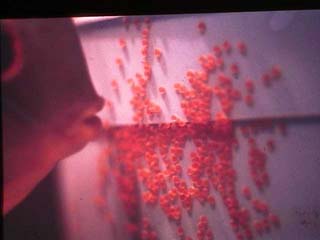
These red discus laid on an icecream dish. Notice the colour of the eggs..

Brown discus with eggs. The white ones are infertile.

Mexican Walking Fish (Also known as Axolotyls) usually breed during winter. Sometimes we add ice to the aquarium to stimulate them. The eggs are encased in a jelly, rather like frogs' eggs. To come into breeding condition, the parents have been fed a variety of food such as earth worms, raw steak cut into long thin strips, and strips of fish fillets.
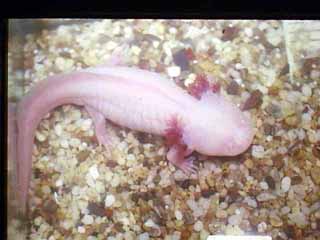
The eggs are laid on the bottom and on the plants.

The white eggs are encased in jelly.

This baby Mexican Waling Fish is only a few hours old.
Ancistrus Catfish

Ancistrus Catfish (or Bristlenose) prefer to lay their eggs inside a clay pot. The eggs are stuck together in a clump. The male cares for the eggs,circulating the water over them.

Some of these eggs have hatched. Eyes can be seen in the unhatched eggs.

Albino Catfish
When ready to lay, the female cleans several places on the side of the glass of the aquarium. She settles on the bottom of the aquarium and lays several eggs. The male fertilizes them, then the female picks them up with her ventral fins, swims to the cleaned glass and gently presses the eggs to the glass where they stick.

Corydoras (Albino) Catfish laying eggs.
Goldfish
Goldfish lay adhesive eggs and scatter them. They stick to whatever they touch. If they lay in plants, we remove them to hatch in a separate aquarium as the parents eat the eggs as soon as they finish laying. I often use coconut fibre as in the next photo.
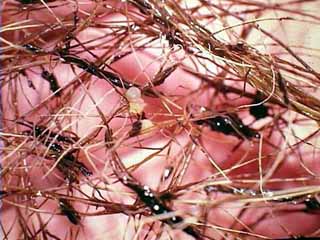
Goldfish eggs in coconut fibre.
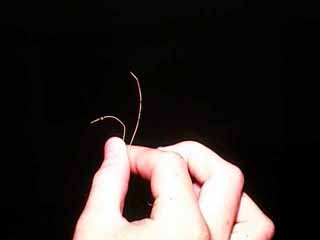
The size of the egg can be seen which is stuck near the end of the fibre.
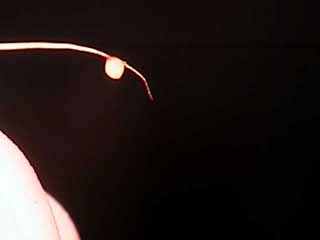
Close-up of a Goldfish egg.
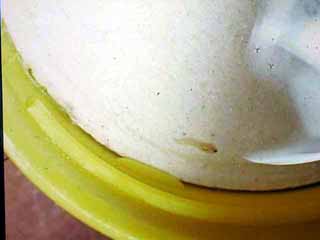
This baby goldfish, only a few hours old, is in a small coffee-jar lid.
Mystery Snails
Mystery Snails lay their eggs above the water level. Eggs are extruded one by one and joined by a sticky mass until a clump have been laid.
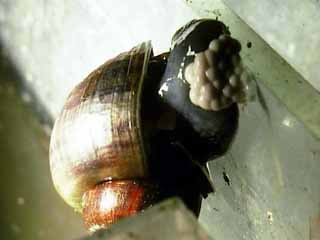
Commencing to lay.

The egg is just appearing.

To hatch the eggs, I remove them and place them on a board supported by a couple of pieces of coolite. This allows sufficient moisture to keep them damp but not wet. The black parts are the ones that have already hatched, the grey are ready to hatch, the pink still have a few days to go.
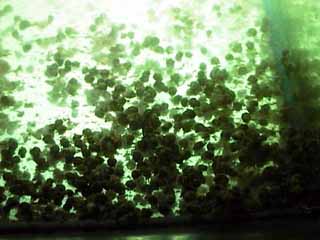
These baby snails crawl to the bottom shortly after hatching in search of food. Their shells are still very soft, so no fish are allowed in this aquarium.
Oscars,
Zebra
Danios,
Angels,
Siamese
Fighters,
Opaline
Gourami,
Orange
Chromide,
Lamington
Crayfish
Ancistrus
| This
Australian
Aquaria Webring Site |
|
 |
|
| [
Ring
Info ][ Next]
[ Previous
] [ Random
] [ List Sites ] The Australian Aquaria Webring is managed by Shanie O'Connor This webring is made possible by WebRing |